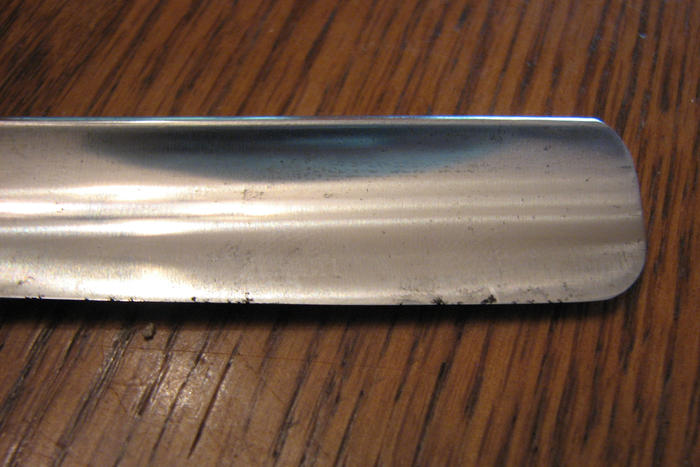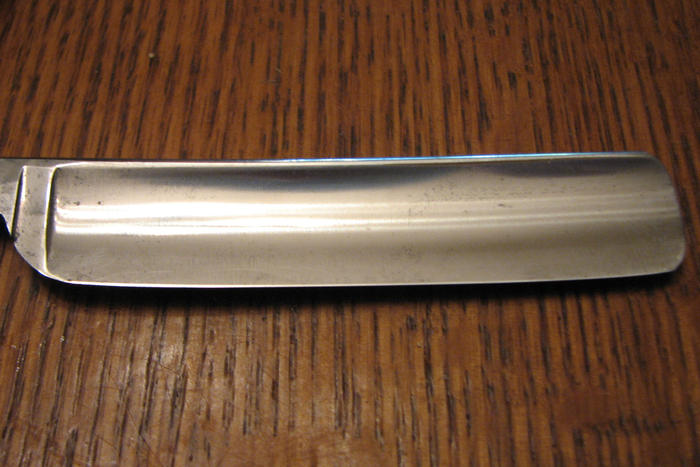Results 1 to 10 of 14
Thread: Bread knifing
-
10-28-2011, 07:53 PM #1
 Bread knifing
Bread knifing
I'm a little confused.
When doing this to even out a blade and even out small chips, are you basically cutting/sawing the stone with the blade? How much pressure?
-
10-28-2011, 07:54 PM #2I shave with a spoon on a stick.



- Join Date
- Jan 2009
- Location
- Stay away stalker!
- Posts
- 4,578
- Blog Entries
- 1
Thanked: 1262
Dont do it!
-
10-28-2011, 08:03 PM #3

Bread knifing is not a good method to use. It gives a false sense of accomplishment when in fact it doesn't really save any time. You would be better off using tape or just hold the razor with the spins slightly off the hone. If you keep a steady pace you can work one side for a minute and then switch to the other side. More time per side is fine if you need to. Use a course hone like a 220 or something in that range. After you get the edge even or the chips/crack removed you can lay the blade on the hone for a proper edge. I working the edge in this manor you will not need to work the complete bevel as in bread knifing. Than again, if that is what you want to do go for it. Pressure or no pressure the goal is to remove as much metal as fast as possible using either method but pressure helps. Good luck.
“If you always do what you always did, you will always get what you always got.” (A. Einstein)
-
10-28-2011, 08:18 PM #4

I haven't read Dante in a long time but I think he said people who bread knife razors go to the ninth circle of hell ...... correct me if I'm wrong .
 Be careful how you treat people on your way up, you may meet them again on your way back down.
Be careful how you treat people on your way up, you may meet them again on your way back down.
-
10-28-2011, 09:15 PM #5

I have a old razor that I'm practicing with that has some spots that look like a steak knife. No luck removing the tough spots on my 220, figured I'd try something different.
-
10-28-2011, 09:17 PM #6
-
10-28-2011, 09:30 PM #7

When working with straight razors it's best if you work it this way:
1) make sure you are having fun while working on your razors or at least enjoy what you are doing
2) experiment starting with the least destructive approach
3) pay attention to what you are doing and what is happening as a result
4) test the results of your work with a shave
5) revise your approach to your work if the results to not meet your expectations, if the do, move on
If I told you haw many layers of tale or how much pressure to the milligram you would not be having fun or learning from you work. Unless your hone is made of wax I doubt you will ruin the hone before you ruin the razor. Good luck.“If you always do what you always did, you will always get what you always got.” (A. Einstein)
-
10-28-2011, 09:32 PM #8

Do what Joe said above. Start with the spine slightly off of the stone and when you've made enough headway tape the spine. Depending on the situation some guys use 3 layers or less. I generally would use one and replace it if it is wearing. Use about as much pressure as in sharpening a knife when you are working on getting the chips out and pay attention to the blade profile. Smile and the world and the razor smiles with you. No one likes a frown.
Be careful how you treat people on your way up, you may meet them again on your way back down.
-
10-28-2011, 09:48 PM #9

Last edited by nun2sharp; 10-28-2011 at 10:08 PM.
It is easier to fool people than to convince them they have been fooled. Twain
-
10-28-2011, 10:03 PM #10

Another (of the many) thing(s) I learned from Glen (gssixgun) is the utility of the DMT Coarse (325) plate. It can eliminate the need to do a true breadknifing. I have done a couple razors recently that had badly rusted edges. The DMT 325 is the perfect tool to take the rotten steel down to clean so you can start the bevel. I put 2 or 3 layers of tape on the spine, but start off doing circles with the spine off the plate - maybe 30 to 45 degrees. As you work through the rust/pits/nicks lay the razor flatter until the tape is on the plate. Then, with 1 layer of tape, start your bevel setting on the 1K. You will have to take the shoulders off the wider bevel you just made on the DMT, but this is still waaaaay faster and easier than starting with the square edge you would get if you breadknifed.


-
The Following User Says Thank You to coloshaver For This Useful Post:
Hirlau (10-29-2011)


 10Likes
10Likes LinkBack URL
LinkBack URL About LinkBacks
About LinkBacks






 Reply With Quote
Reply With Quote



